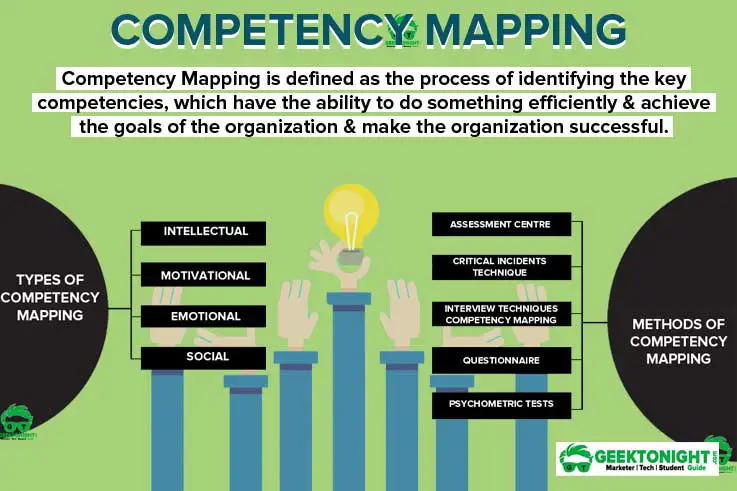Introduction
Competency mapping is the systematic identification of knowledge, skills, abilities, and other characteristics (KSAOs) required to perform effectively in a specific role or function. It enables alignment between individual capabilities and organizational goals, thereby enhancing strategic human resource management (Cascio & Aguinis, 2018).
Read More: Personnel Psychology
Theoretical Background and Significance
The roots of competency mapping lie in applied industrial-organizational psychology, which emphasizes the importance of valid job-person fit for enhanced productivity and work satisfaction. Early research by McClelland, followed by applications in HR by practitioners, led to today’s competency frameworks (Aamodt, 2015). Cascio (2010) underscores the role of competencies in driving performance, especially when integrated into recruitment, training, and appraisal systems.
Types of Competencies
- Technical Competencies – Job-specific expertise, such as coding, accounting, or equipment handling.
- Behavioral Competencies – Interpersonal or cognitive traits like teamwork, adaptability, and decision-making.
- Leadership Competencies – Strategic vision, influencing ability, and innovation.
- Core Competencies – Values shared across the organization, such as integrity, customer focus, or ethical behavior.
- Cross-functional Competencies – Broadly applicable skills like communication, project management, and analytical thinking (Cascio & Aguinis, 2018).
The Competency Mapping Process
The competency mapping process includes:

Competency Mapping
1. Job Analysis
Competency mapping begins with job analysis—a structured examination of tasks, responsibilities, and required capabilities. Techniques include job observation, structured interviews, critical incident techniques (CIT), and Position Analysis Questionnaires (PAQ). The goal is to understand the actual behavior and capabilities required for effective performance (Aamodt, 2015).
2. Identification of Competencies
Once tasks are clarified, subject matter experts (SMEs) and job incumbents contribute to identifying the key competencies. These are then validated against performance outcomes and organizational objectives.
3. Establishing Proficiency Levels
Each competency is mapped to different proficiency levels, such as basic, intermediate, advanced, or expert. This allows for role-specific benchmarks and guides professional development (Cascio, 2010).
4. Validation and Framework Design
The set of competencies is grouped into categories, reviewed for overlaps, and structured into a competency framework. Validation occurs through pilot testing and focus group feedback involving HR and business leaders.
Integration into HR Functions
Once finalized, the framework is embedded into core HR practices:
- Recruitment and selection
- Employee training and development
- Succession planning
- Performance management systems (Cascio & Aguinis, 2018)
Strategic Value of Competency Mapping

Competency Mapping
Competency mapping plays a pivotal role in aligning talent management with organizational strategy. Key benefits include:
- Enhanced Job-Person Fit – Reduces turnover and improves job satisfaction.
- Clear Development Paths – Supports career planning and employee growth.
- Objective Assessment Criteria – Improves fairness in performance appraisal.
- Organizational Alignment – Ensures employee capabilities meet business needs (Cascio, 2010).
Challenges and Limitations
Despite its strategic advantages, competency mapping is not without difficulties:
- Time and Resource Intensive – Requires commitment from multiple stakeholders.
- Subjectivity in Competency Definition – Risk of bias in identifying and rating competencies.
- Resistance to Change – Employees may be skeptical of revised performance expectations.
- Over-complexity – Large competency models may become unwieldy and impractical (Aamodt, 2015).
Best Practices
To maximize effectiveness, organizations should:
- Involve Stakeholders – Engage HR, line managers, and employees in the process.
- Ensure Alignment with Strategy – Reflect business priorities in competencies.
- Use Validated Tools – Rely on evidence-based instruments for analysis and assessment.
- Maintain Flexibility – Update the framework regularly in response to industry trends and organizational change (Cascio & Aguinis, 2018).
Conclusion
Competency mapping is a powerful HR tool that enhances organizational performance by ensuring alignment between roles and individual capabilities. When implemented thoughtfully using structured job analysis and validated models, it promotes efficiency, adaptability, and engagement. For organizations aiming to remain competitive in a dynamic environment, competency mapping offers a reliable roadmap for talent optimization and strategic HR planning.
References
Aamodt, M. G. (2015). Industrial/Organizational Psychology: An Applied Approach. Cengage Learning.
Cascio, W. F. (2010). Managing Human Resources: Productivity, Quality of Work Life, Profits. McGraw-Hill Education.
Cascio, W. F., & Aguinis, H. (2018). Applied Psychology in Human Resource Management. Pearson.
Niwlikar, B. A. (2025, August 12). Competency Mapping and 4 Important Processes in It. Careershodh. https://www.careershodh.com/competency-mapping/
